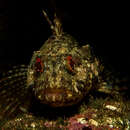Biology
(
englanti
)
tarjonnut Fishbase
Feeds mainly on amphipods as juveniles and shifts to diet of decapods as adults (Ref. 94105).
- lisenssi
- cc-by-nc
- tekijänoikeus
- FishBase
- Recorder
- Cristina V. Garilao
Comprehensive Description
(
englanti
)
tarjonnut Smithsonian Contributions to Zoology
Calliclinus geniguttatus (Valenciennes)
Clinus geniguttatus Valenciennes in Cuvier and Valenciennes, 1836:386 [Valparaiso, 3 syntypes, MNHN A. 2069; lectotype is herein designated: the largest of the syntypes, 120 mm SL; the paralectotypes are 91 mm SL and 110 mm SL].
Clinus elegans Valenciennes in Cuvier and Valenciennes 1836: 386 [Valparaiso, 2 syntypes, MNHN A. 2073].
Clinus guttulatus Valenciennes in Cuvier and Valenciennes, 1836:387 [Valparaiso, type missing; the lectotype of Clinus geniguttatus, MNHN A. 2069, is herein designated as neotype of C. guttulatus; see discussion below].
Clinus guttatus Guichenot in Gay 1848:248 [mispelling of guttulatus].
Labrisomus conventryi Fowler, 1940:187 [Mocha, Chile; holotype, ANSP 69149].
Pennaclinus racemarius DeBuen, 1962:82 [Chan Chan in Valdivia; depository of holotype not given, type probably destroyed].
DESCRIPTION.—Dorsal fin XXIV-XXV,11–13 (24.9, 12.1); total dorsal-fin elements 36–38 (37); anal fin II,20–22 (21.4); pectoral fin 15; pelvic fin I,4; caudal fin 13 (7–9 branched); lateral-line scales 41–45 (43.4); vertebrae 13–14 + 27–29 = 41–43 (usually 14 + 28).
Morphometrics based on sixteen specimens: SL 33.0–114.0 mm; head length 25.6–31.0; head depth 19.1–23.3; head width 16.0–21.4; upper jaw length 12.4–16.0; eye diameter 6.4–9.7; snout length 7.1–8.3; interorbital width 3.0–4.5; predorsal length 19.7–25.3; preanal length 48.3–53.0; caudal-peduncle depth 8.0–9.7; caudal-peduncle length 5.7–8.9; pectoral-fin length 15.4–24.8; pelvic-fin length 13.2–18.7; first dorsal-fin spine length 6.3–9.1; fourth dorsal-fin spine length 7.6–10.9.
Orbital cirri: Multifid, bushlike, 10–20 branches arising from well-developed common stalk, entire cirrus usually less than half orbit in length; nasal cirri: smaller than orbital cirrus, multifid, 5–10 branches, less than one-third orbital length; nape cirri: 3 patches, each oriented transversely, each patch with 1–16 simple, fringelike cirri, each lateral patch slightly posterior to median patch; jaw teeth consisting of enlarged outer row with well-developed patches of minute teeth posteromedially; upper jaw teeth occur posteriorly only slightly more than half distance to rictus; palatines and vomer with continuous patches of small teeth; gill rakers 2 + 6 − 7 on first arch; spinous dorsal fin uniformly low, first dorsal-fin ray twice length last spine, last ray bound to peduncle for half ray length; anal fin not adnate to peduncle; pectoral fin rounded; pelvic fin rounded; pelvic fin with second ray longest, first and third rays approximately equal, fourth ray (innermost) shortest, membrane incised between first and second rays only.
Body elongate, somewhat compressed; greatest body depth 3.5–4.0 in SL; head depth greater than head width; jaws terminate posteriorly near posterior border of orbit; scales smaller on belly and pectoral-fin base than on remainder of body; no scales on head anterior to nape or on fin membranes; well-developed sensory pores on dorsal half of head, sometimes raised.
Color in alcohol: General ground color light to dark brown; body irregularly marked with dark (brown to black) mottling, sometimes appearing as indistinct bars; occasionally 5–6 well-developed, black rectangular blotches along dorsal fin base; blotches sometimes continuing as irregular bands across body, usually not quite reaching anal fin but extending onto fin rarely; blotches usually continuous with mottling on dorsal fin; dorsal and lateral aspect of head dark brown; dark brown spots usually covering cheek and suborbital region; under surface of lower jaw and branchiostegal membrane unmarked, lighter; all fins except pelvics with some spotting, a few discernible bands usually visible on caudal fin; cirri dark brown at base, unpigmented at tips. No obvious sexual dichromatism.
Markings most distinct on specimens less than 80 mm SL. Specimens smaller than 50 mm SL with distinct markings on head: oblique bar originating at midventral edge of orbit and extending posterio-ventrally to posterior edge of preopercle; well-developed blotch on posterior rim of orbit and series of 5–6 marks along opercle, appearing to be remnants of additional indistinct oblique bars; dorsal fin with well-defined ocellus between second and fourth spines, covering most of fin membrane (only faintly visible in larger specimens).
- bibliografinen lainaus
- Stephens, John Stewart and Springer, Victor G. 1973. "Clinid fishes of Chile and Peru, with description of a new species, Myxodes ornatus, from Chile." Smithsonian Contributions to Zoology. 1-24. https://doi.org/10.5479/si.00810282.159
Calliclinus geniguttatus: Brief Summary
(
englanti
)
tarjonnut wikipedia EN
Calliclinus geniguttatus is a species of labrisomid blenny native to the Pacific coast of Chile and the Atlantic coast of Argentina. This species primarily preys on amphipods when young, shifting to decapods as they mature. It can reach a length of 12.2 centimetres (4.8 in) TL.
- lisenssi
- cc-by-sa-3.0
- tekijänoikeus
- Wikipedia authors and editors
Calliclinus geniguttatus
(
baski
)
tarjonnut wikipedia EU
(RLQ=window.RLQ||[]).push(function(){mw.log.warn("Gadget "ErrefAurrebista" was not loaded. Please migrate it to use ResourceLoader. See u003Chttps://eu.wikipedia.org/wiki/Berezi:Gadgetaku003E.");});
- lisenssi
- cc-by-sa-3.0
- tekijänoikeus
- Wikipediako egileak eta editoreak
Calliclinus geniguttatus: Brief Summary
(
baski
)
tarjonnut wikipedia EU
Calliclinus geniguttatus Calliclinus generoko animalia da. Arrainen barruko Labrisomidae familian sailkatzen da.
- lisenssi
- cc-by-sa-3.0
- tekijänoikeus
- Wikipediako egileak eta editoreak
Calliclinus geniguttatus: Brief Summary
(
ranska
)
tarjonnut wikipedia FR
Calliclinus geniguttatus est une espèce de poissons marins de la famille des Labrisomidae et de l'ordre des Perciformes. Cette espèce est native de la côte Pacifique du Chili et de la côte Atlantique de l'Argentine. Elle se nourrit principalement d'amphipodes lorsqu'elle est immature, puis elle tourne vers les décapodes lorsqu'elle devient mature. Elle peut alors atteindre une longueur de 12,2 centimètres.
- lisenssi
- cc-by-sa-3.0
- tekijänoikeus
- Auteurs et éditeurs de Wikipedia

